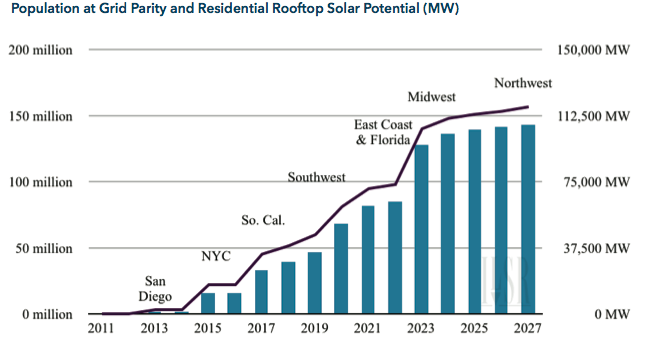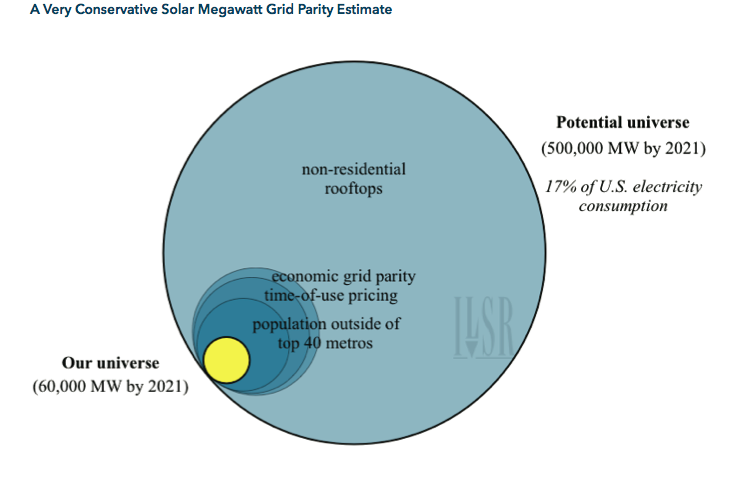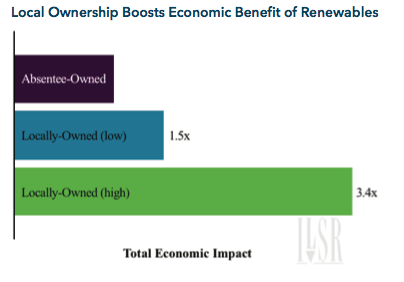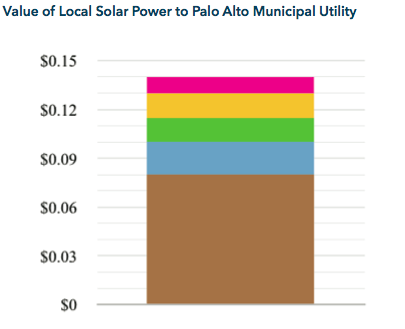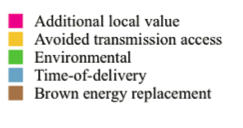Tuesday, December 31, 2013
Carlyle Capital Markets to Source Capital for Principal Solar Project Acquisition and Development - Global Energy World - Be the first to know
--
Monty Bannerman
ArcStar Energy
646.402.5076
www.arcstarenergy.com
Friday, December 20, 2013
Fwd: CNN Breaking News
From: "CNN Breaking News" <BreakingNews@mail.cnn.com>
Date: Dec 20, 2013 9:31 AM
Subject: CNN Breaking News
To: <textbreakingnews@ema3lsv06.turner.com>
Cc:
Wow! The U.S. economy suddenly looks a lot perkier in the third quarter than originally thought, according to revised data released by the government today.
Gross domestic product -- the broadest measure of economic activity -- grew at a 4.1% annual pace in the third quarter, up from the 2.8% pace that was originally reported in November. The government typically reports its GDP figures at least three times, and today's report is the final number for the third quarter.
This is encouraging news, especially after economists had largely written off the previous GDP revision for the third quarter because much of the growth came from businesses building up their inventories.
Get complete coverage of breaking news on CNN TV, CNN.com and CNN Mobile.
------------------------------------------------------------------
CNN is now LIVE anywhere you want it.
You can watch live CNN TV at http://CNN.com/CNNtv
or on the CNN Apps for iPhone, iPad and Android.
Contact your cable, satellite or telco provider for availability.
------------------------------------------------------------------
You have opted-in to receive this e-mail from CNN.com. To unsubscribe from Breaking News e-mail alerts, go to: http://cgi.cnn.com/m/clik?l=textbreakingnews
One CNN Center Atlanta, GA 30303
(c) & (r) 2013 Cable News Network
MMWEC, First Wind Sign Contract for Hancock Wind Project Energy | Electric Power News | Energy Central
--
Monty Bannerman
ArcStar Energy
646.402.5076
www.arcstarenergy.com
Wednesday, December 18, 2013
Fwd: The Solar Opportunity
The Solar Opportunity
John Farrell
December 16, 2013 | 7 Comments
| | | |
The coming of solar grid parity offers an opportunity for millions of Americans to go solar affordably. But it also means a potential transformation, a democratization of an electricity system long dominated by centrally-controlled utilities and centralized ownership and production of electricity. When solar can undercut grid electricity prices, it may also undercut this 20th century system of centralized ownership, bringing economic sunshine and self-reliance to communities along with solar electricity.
This is the third of five parts of our Rooftop Revolution report being published in serial. Read Part 1 or Part 2. Download the entire report and see our other resources here.
Millions of People, Thousand of Megawatts
When solar grid parity arrives, it won't mean that everyone can go solar. The most likely participants in the residential sector will be folks who own their own home. Even then, there will be some homes whose roof is unsuitable for solar power for one reason or another (e.g. shading). The following analysis takes the year of solar grid parity for the nation's largest cities and translates it into megawatts of solar power potential.
We used the following assumptions to calculate the residential solar rooftop potential for each metropolitan area:
- Only non-vacant, owner-occupied properties were considered. Nationally, about two-thirds of homes are owner-occupied and not vacant, with major metropolitan areas varying from 50 to 70 percent.
- We estimated approximately 1,000 square feet of total roof space per home.
- We assumed that only 27 percent of this space (in the aggregate) would be suitable for solar, based on national studies of rooftop solar potential.
- We assumed that 1 kW of solar could be installed for every 100 s.f. of suitable roof space.
With these assumptions, we can use our previous analysis of the year of solar grid parity (based on the average residential retail electricity rate) to estimate the potential capacity of solar power that could be installed on home rooftops at grid-beating prices each year until 2027.
The above chart is quite conservative. For one, the data only reflect the 50% of Americans that live in the largest 40 metropolitan areas. Additionally, we used average grid prices and did not factor in time-of-use pricing or "economic grid parity." Finally, residential solar is only a fraction of the total solar market. In California, the largest U.S. solar market, residential solar represents approximately 30% of the installed capacity in the California Solar Initiative program. Thus, the grid parity potential numbers above are a fraction of the actual solar potential when considering commercial and public sector property as well as communities smaller than the 40 largest cities.
Additionally, rooftops aren't the only place for solar, and the availability of other locations could further expand the grid parity opportunity, such as parking lots, near highways, underneath existing transmission lines, and on the ground near existing buildings.
Jobs and Economic Development
Solar provides an unparalleled economic opportunity for local power generation and local economic benefits. Each megawatt of solar power generates as many as eight jobs and $240,000 in economic activity, and most solar power projects can be built right next to or on top of the building that will use the electricity.
Previous studies by the National Renewable Energy Laboratory indicate that locally owned renewable energy projects multiply the job and economic benefits of renewable energy projects.
With a potential for 30,000 megawatts of residential solar in the next 6 years, communities across the country could gain over a quarter million jobs and create over $18 billion in economic activity.
Value to the Electricity System
There's also ample evidence that distributed solar power has much greater value to the grid than simply electricity output. The delivery of power during peak periods (covered by time-of-use pricing) is just one element. The ability of solar to avoid transmission access charges, supplant long-distance power sources, reduce stress on the distribution system during peak power events and hedge against fossil fuel price fluctuations can vary from $0.03 to $0.14 per kWh. Solar also has environmental benefits (relative to existing power production) that provide additional value.4
The following chart illustrates how utilities are recognizing the value of solar power, illustrating the willingness of a municipal utility to pay more for local solar power because of its various grid and local economic benefits.
Democratizing the Electricity System
Perhaps the greatest benefit of the solar grid parity opportunity will be its political impact. As millions of Americans become self-reliant energy producers, it will create an enormous constituency for continued support of distributed renewable energy development and distributed solar in particular.
The information and views expressed in this blog post are solely those of the author and not necessarily those of RenewableEnergyWorld.com or the companies that advertise on this Web site and other publications. This blog was posted directly by the author and was not reviewed for accuracy, spelling or grammar.
--
Monty Bannerman
ArcStar Energy
646.402.5076
www.arcstarenergy.com
Another ArcStar market-leading proposition gets traction (somewhere else)
SMA commissions PV-diesel hybrid system in the APAC region | ||
|
Monty Bannerman
ArcStar Energy
646.402.5076
FPL proposes charging customers to upgrade emissions | RenewablesBiz
FPL never misses an opportunity to abuse its monopoly position.
Tuesday, December 17, 2013
Outgoing GM CEO: Taxpayers Gained On Bailout
Candidate for 2013 most monstrous non-sequitur of the year.
Monday, December 16, 2013
Saturday, December 14, 2013
Fwd: Major European Utility Set for Dramatic Renewable Energy Transformation
Major European Utility Set for Dramatic Renewable Energy Transformation
Diarmaid Williams, International Digital Editor, Power Engineering International
October 31, 2013 | 13 Comments
|
|
|
| | |
LONDON -- One of Europe's largest utilities is on the cusp of reportedly transforming its business from being a centralised energy provider into a decentralized energy provider.
According to energycollective.com, the board of Germany's RWE (FWB: RWE) agreed last month on the momentous change in strategy and the move is now being evaluated within the company at large as well as investors.
A recent strategy paper gives further credence to the decision, as it proclaimed, "The massive erosion of wholesale prices caused by the growth of German photovoltaics constitutes a serious problem for RWE which may even threaten the company's survival."
RWE confirmed to website Energy Post that the new strategy has been discussed within the company and with investors.
According to the documents, RWE wants to depart from its traditional developer and ownership roles of centralized power plants and instead help use its expertise to help manage and integrate renewables into the grid.
"The guiding principle is 'from volume to value' with technologies ranging from large-scale offshore wind and hydro to onshore wind or photovoltaic. But we will no longer pursue volume or percentage targets in renewables. We will rather leverage our skill set by taking a 'capital-light' approach. Based on funds sourced largely from third parties, we will position ourselves as a project enabler and operator, and [as a] system integrator of renewables," read the documents published by Energy Post.
"Developing an innovative and profitable prosumer business model is a challenge we also need to address successfully, as we see a billion-euro market emerging alongside our traditional value chain."
RWE's share price has lost one-third of its value over the last three years due to the European energy transition and the company now looks to be addressing the possibility of further shrinkage in the most dramatic way possible.
Meanwhile chairman of the supervisor board at RWE Innogy, Dr Fritz Vahrenholt, told Power Engineering International midweek that despite reports in the German press, "there is no RWE strategy to transform its business completely to renewables. The last target for renewables was 25 percent of the capacity (not production) in 2025. Today 95 percent of the power is conventional. But because of the devastation of the market many of the power stations are out of money."
"RWE is shifting their activities to sales, trading and decentralized power."
Handelsblatt appears to back up his contention that there will remain a proportion of the business dedicated to conventional power, even if RWE Chief Executive Peter Terium wants no further investments in fossil-fuelled powered plants, according to the German daily.
"In 2020, conventional forms of power generation should contribute no more than one fifth of the operating result", according to Mr. Terium's plans, the article says. He also wants to develop new business models for decentralized power distribution, Handelsblatt reports.
This article was originally published on Power Engineering International and was republished with permission.
--
Monty Bannerman
ArcStar Energy
646.402.5076
www.arcstarenergy.com
Friday, December 13, 2013
Thursday, December 12, 2013
Fwd: California passes first energy storage mandate in U.S. - Pennenergy
Monty Bannerman
ArcStar Energy
+1 646-402-5076
---------- Forwarded message ----------
From: "Rebecca Van Nichols" <rvan@tnag.net>
Date: Dec 12, 2013 4:19 PM
Subject: California passes first energy storage mandate in U.S. - Pennenergy
To: "M" <mbannerman@arcstarenergy.com>
Cc:
> http://www.pennenergy.com/articles/pennenergy/2013/10/california-passes-first-energy-storage-mandate-in-u-s.html?cmpid=EnlWeeklyPowerOctober252013
>
> California passes first energy storage mandate in U.S.
> October 17, 2013
> By Dorothy Davis
> Content Director
>
> In a unanimous vote, the California Public Utilities Commission (PUC) has enacted the first energy storage mandate in the United States. Under the new mandate investor-owned utilities will be required to purchase at least 200 megawatts (MW) of energy storage by 2014 and 1,325 MW by 2020.
>
> Within a traditional system, utilities simply shed excess energy during off-peak production times, and must utilize back-up power stations during peak demand. Energy storage has long been held as an industry ideal, but the development of cost-effective technologies has not progressed very quickly overall.
>
> According to the U.S. Energy Information Administration (EIA), costs can be significant when it comes to energy storage, particularly with emerging technologies. On the other hand, electricity storage technologies offer price arbitrage opportunities and fast-response services that conventional technologies cannot match.
>
> The EIA further asserts the future utilization of energy storage will depend on how rapidly the technologies improve and costs drop, the implementation of new pricing and valuation schemes for the services storage can provide, and the cost and efficiency of alternatives.
>
> California's decision on energy storage therefore sets a precedent for the U.S. energy industry. The mandate is meant to spur advancement in the development and use of energy storage technologies, and if successful could serve to significantly address issues such as grid stability during extreme weather and managing intermittency due to renewables.
>
> Once again California has set itself ahead of the curve on energy policy and will continue to be watched closely as its innovative and aggressive renewable power and energy storage mandates take shape in the broader market
Monday, December 9, 2013
Canadian Solar Subsidiary Sky Solar commits to Uruguay Project
Tecnova Renovables breaks ground on 1.7 MW PV project in Uruguay | |
|
Monty Bannerman
ArcStar Energy
646.402.5076
Brazil heats up
France group Casino expands into Brazilian solar market | |
|
Monty Bannerman
ArcStar Energy
646.402.5076
Sunday, December 8, 2013
Mitigating Wind & Solar Risks
Mitigating Renewable Energy Risk
David Appleyard, Senior Editor, Renewable Energy World
November 25, 2013
With the majority of people wanting more emphasis on domestic production of renewable energy what do wind and solar installation operators need to know if they are ramping up their production and seeking to better maintain their existing fleet. David Appleyard spoke with Lauren Berry, vice president at insurance company Travelers who highlights some key risk management techniques.
"Understanding a renewable energy farm's building and operating risks can make financing a renewable project much easier. For example, when owners can illustrate to lenders that they have anticipated their risk exposures, minimized the potential for interruptions and that the renewable energy farm will be properly insured from the start, banks and investors are more likely to provide the requested financing." -- Lauren Berry, Vice President, Travelers
Q: What risk management tactics can solar and wind farm operators employ to mitigate risks?
A: Some carriers provide proactive risk assessments to identify and suggest ways to mitigate risk. For example, one of the biggest risks operators face is theft, given the highly valuable equipment and materials that make up wind and solar farms. If a high risk of theft is identified as part of a proactive risk assessment, mitigation measures that can be taken to protect against theft may be recommended. Such preventive measures can include connecting panels to an alarm system, installing solar panel fasteners, or etching individual ID codes on panels so they are readily identifiable if stolen.
Q: What should wind and solar operators keep in mind as they expand their operations?
A: As solar and wind farm operators grow their businesses, it is important to consider often-overlooked processes that evolve with the business, such as transportation risks. Longer hauls and bigger shipments create greater potential for generating revenue – and greater risk. When an operation begins moving more costly and oversized solar panels, 50-ton wind turbines, or 150-foot blades for example, safe transit is not a minor detail. In fact, according to an industry report by the University of California Irvine, turbine transportation costs account for 20% of a project's total cost.
Also, as a wind or solar business evolves, the need for more land is often necessary. Many solar and wind farm operators fail to recognize that such farms are sometimes built on what is largely unusable property for other purposes because of flood exposure or other potential hazards. Developers should be consulting with their design team and their insurance carrier's risk control team to review the site and the unique exposures that the site may present, and then proactively addressing any exposures identified. For example, if a farm is located in a flood plain, the electrical junction boxes and inverters should be elevated above historical flood water levels. This simple step may minimize an operator's potential loss, and, as a result may make their operation more profitable.
Q: What insurance solutions do solar and wind farm operators need to know about?
A: Increased demand for renewable energy options present new growth opportunities for solar and wind power operators. Operators should seek insurance solutions from providers with an established track record and deep industry expertise. It's important to find solutions that offer a holistic approach to risk management and the flexibility to grow as the industry evolves. Some products are designed to meet the specific needs of wind and solar farm operators so that in the event of a loss, their profit margins are protected. For example, such insurance would cover the costs associated with a business interruption that impacts the ability to produce power.
Q: How can proper risk mitigation and insurance coverage help increase the success of renewable energy facilities?
A: Having the right advisors assist with the development of a risk management plan and the right insurance coverage in place should lessen the focus on the potential for loss and financial setback, allowing energy facilities to put their focus on the potential for sustainable growth and continued innovation.
Q: How do these techniques apply elsewhere?
A: Understanding a renewable energy farm's building and operating risks can make financing a renewable project much easier. For example, when owners can illustrate to lenders that they have anticipated their risk exposures, minimized the potential for interruptions and that the renewable energy farm will be properly insured from the start, banks and investors are more likely to provide the requested financing. Considering that competition for financing continues to increase with the growth of the renewable industry, risk management is more of an invaluable tool than ever.
Q: How can risk management techniques improve the cost effectiveness of renewable energy?
A: Mindful renewable energy operators do not rely solely on warranties for their equipment, but also implement proactive maintenance measures. Scheduling diagnostic tests as part of a regular maintenance program allows owners to troubleshoot areas that are prone to malfunction, preventing interruption and the resulting power outage and profitability that outages can cause. Smaller investments over time in proper maintenance and diagnostic testing extends the lifetime of equipment and helps make sure that renewable operators avoid hefty, unwanted repair expenses and lost revenue.
Q: Are there any new risk management techniques that have emerged that are impacting on the sector?
A: For wind operators, battery load tests, oil and vibration analyses and boroscope inspections can serve as important early indicators of problems and are important components of proper risk management. For solar operators, monitoring electrical connections, combiner boxes and air filters are essential as loose overloaded electrical connections can lead to equipment breakdown from overheated and overextended inverters. Panels should also be cleaned to maintain their energy output. For both wind and solar energy operators, working with an experienced agent and broker with extensive knowledge about the renewable energy space is essential. They can provide a risk-assessment on the farm to identify where potentially overlooked risk exposures are, advise about the most reliable contractors to work with and provide the insurance coverage solutions that make the most sense for the needs of a renewable energy farm owner or operator.
Friday, December 6, 2013
Fwd: Solar Growth Outpaces Wind for First Time - Power Engineering
Solar Growth Outpaces Wind for First Time

By Tildy Bayar, Associate Editor, Renewable Energy World
A strong showing from global solar photovoltaic (PV) installations, coupled with a sharp fall in new wind capacity, has led to solar growth outpacing wind this year – for the first time ever.
Analysis from Bloomberg New Energy Finance predicts that 36.7 GW in new solar PV capacity will be added worldwide in 2013, compared with 35.5 GW in new wind installations (33.8 GW onshore and 1.7 GW offshore).
Both wind and solar PV broke records last year, with onshore and offshore wind adding 46.6 GW and solar PV adding 30.5 GW. But 2013's slowdown in the two largest wind markets, China and the U.S., is opening the way for the rapidly growing PV market to overtake wind, BNEF said.
Justin Wu, BNEF's head of wind analysis, said, "We forecast that wind installations will shrink by nearly 25 percent in 2013, to their lowest level since 2008, reflecting slowdowns in the U.S. and China caused by policy uncertainty."
In the U.S., the repeated last-minute extension of the Production Tax Credit has created what analysts have called a perpetual boom-and-bust cycle. This year's uncertainty led to a drop in investment, causing significant layoffs and facility closures across the wind supply chain.
In China, where the industry has suffered from curtailment due to insufficient infrastructure and tightened standards for wind turbines have slowed development, the sector has been expecting further policy announcements after the government raised this year's new-capacity target to 18 GW in January.
In particular, developers say China's feed-in tariff (FiT) for offshore wind is too low given the higher costs of offshore development, leading to predictions that the nation will fail to meet its offshore goal of 5 GW by 2015. The government has said it will re-think the FiT, but has offered no timetable.
Globally, demand for wind turbines is predicted to shrink by 5 percent this year, for the first time since 2004.
But wind is still far from dire straits, BNEF reassured. "Falling technology costs, new markets and the growth of the offshore industry will ensure wind remains a leading renewable energy technology," Wu said.
In the solar sector, "the dramatic cost reductions in PV, combined with new incentive regimes in Japan and China, are making possible further, strong growth in volumes," said Jenny Chase, BNEF's head of solar analysis.
In Japan, the fourth country to reach the 10 GW mark in cumulative solar capacity, the attractive FiT has led to rapid growth over the past year, with demand surging in the commercial and utility segments. China, which will be the largest solar market this year according to BNEF, has raised its renewable energy surcharge and revamped its subsidy regime, expanding performance-based incentives for distributed solar power in a bid to grow the domestic market after solar trade spats with Europe and the U.S. The nation aims to more than quadruple its solar power generating capacity to 35 GW by 2015.
Growth in Asia will offset PV's decline in traditional leading regions. "Europe is a declining market," Chase said, "because many countries there are rapidly moving away from incentives, but it will continue to see new PV capacity added."
While the immediate future looks brighter for solar than wind, BNEF predicted that, despite 2013's rankings upset, the maturing onshore wind and solar PV sectors will contribute almost equally to the world's new electricity capacity additions between now and 2030. On- and offshore wind will grow from 5 percent of total installed power generation capacity in 2012 to 17 percent in 2030, while solar PV will increase from a lower base of 2 percent in 2012 to 16 percent by 2030, BNEF said.
The analysis also predicted that technology suppliers in both wind and solar may see a move back to profit as soon as this year, after a prolonged period of oversupply and consolidation.
Michael Liebreich, BNEF's chief executive, commented: "Cost cuts and a refocusing on profitable markets and business segments have bolstered the financial performance of wind turbine makers and the surviving solar manufacturers. Stock market investors have been noticing this change, and clean energy shares have rebounded by 66 percent since their lows of July 2012."
This article was originally published on RenewableEnergyWorld.com. It was republished with permission.

| |
--
Monty Bannerman
ArcStar Energy
646.402.5076
www.arcstarenergy.com

